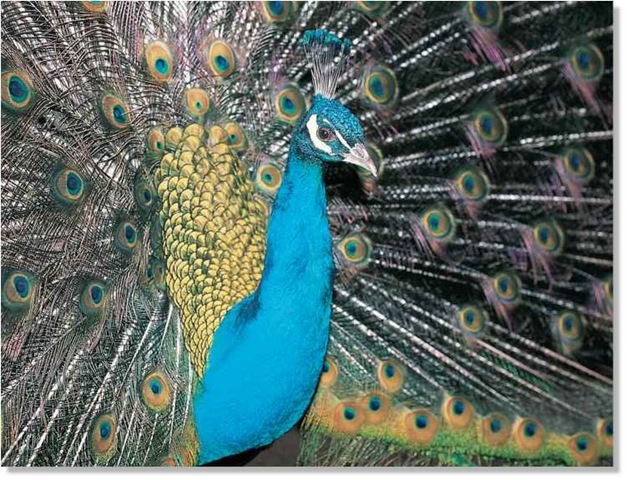ORDER
Galliformes
FAMILY
Phasianidae
GENUS & SPECIES
key features
• One of the most spectacular birds, its long, colorful feathers are used purely for display
• The peacock (male) rules a harem of peahens (females), dazzling them with his shimmering fan
• Considered sacred in some cultures and kept as an ornamental bird around the world

WHERE IN THE WORLD
On the Indian subcontinent: Sri Lanka north to Kashmir and east through Nepal and Bangladesh; extends west into Pakistan to the Indus River; introduced to many other parts of the world
Lifecycle
As he flaunts his incredible finery to woo a mate, the male peafowl is the ultimate animal show-off. It is easy to see why “proud as a peacock” so aptly describes human vanity.
HABITAT
In its wild state, the peafowl lives in hillside jungle and is rarely found far from streams bordered by dense, bushy vegetation. It is usually a bird of low to medium altitude, found up to about 1,980′, although it has been recorded living at 5,940′ in the Himalayas.
In areas where it’s protected, the common peafowl is found around villages. The peafowl can adapt readily to life in small,
DRINKS ALL AROUND
Peafowl and sambar deer isolated patches of woodland share a refreshing drink. or fields of sugarcane.
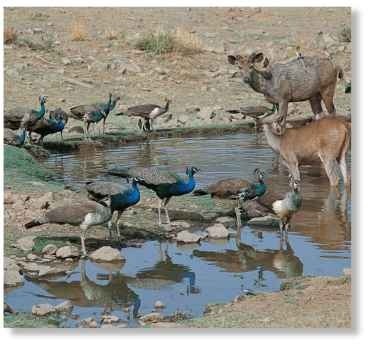
CONSERVATION
The common peafowl enjoys protection as the national bird of India and is sacred in the Hindu religion.The bird is destined to remain a common species in much of its native range. It’s extremely common elsewhere in the world, where it has been introduced mainly for its ornamental value.
BEHAVIOR
BREEDING
The mating season begins with the monsoon (heavy rains), so its chicks benefit from the abundance of food resulting from the rains. Breeding starts in January in Sri Lanka, but in northern areas doesn’t begin until the summer monsoon in June. The male displays to, and mates with, the three to five peahens in his harem. After mating, the female incubates the eggs and tends her chicks, her dull plumage concealing her from predators.
Newly hatched downy chicks instinctively peck at their mother’s bill, from which she offers them tiny bits of food until they feed themselves. At two weeks, the chicks can flutter and jump to accompany their mother on a roosting perch. Young don’t join the main adult roosts until they’re two months old.
STRUTTING PROUD
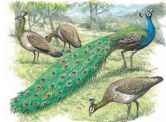
1 Love song…
The peacock is a noisy bird, especially in the mating season. His repeated call asserts his dominance over his harem.

2 First approach…
The male singles out a particular female and begins to spread his magnificent train, cocking his tail to help support his long plumes.
The peafowl is a creature of habit. It stays in the same area year ’round and has a sedate daily routine, disrupted only when forced to flee a predator (a tiger or Indian mongoose).The peafowl has regular sites for feeding, roosting, loafing and courting. It spends the middle of the day in the shade, where it rests and preens. Like other pheasants, the peafowl doesn’t bathe in water, but cleans itself by vigorously rubbing its plumage in dry soil and dust.
Tall trees, with open views of the surrounding countryside, are used for roosting.As many as 100 birds may gather at favored sites. They fly almost vertically into the treetops, their raucous cries carrying far into the forest. In the morning, amid another chorus of loud wailing, they split into small groups. Grazing animals often stampede at the sound of the peafowl’s alarm call, which they recognize as a signal that a big cat may be on the prowl.
Look out! The peacock calls to warn of a predator nearby.
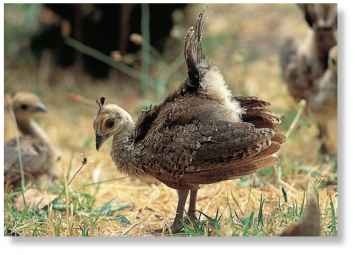
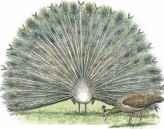
3 Indifference…
With his train fully erected, the peacock struts with his back to the female, fluttering his drooped wings. She appears unimpressed.
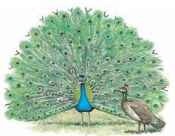
4 Full frontal
Suddenly the peacock spins to show his full, shimmering train. This finally catches her attention and they then mate.
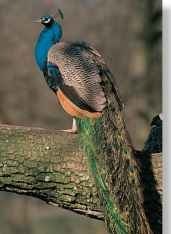
A Ruling the roost The peafowl roosts in trees with open views.
# Peahens and even chicks sometimes spread their short tail coverts to imitate the male’s display.
# At one time, roast peafowl was a fashionable dish at European banquets.
It’s been suggested that the peacock struts around during his display to keep his balance as the wind catches his fanned train.
FOOD & FEEDING
The peafowl will eat virtually any plant or animal matter Wild figs, berries and nuts are favorite foods in season, but seeds, grain and leaves are staple items all year Peafowl can be a pest on farmland, where crops are eaten and also flattened by the males’trains.This aggressive bird will stalk and catch small snakes, mice, other small mammals and insects such as grasshoppers, termites and ants. Groups forage for food as soon as they leave their roosts at
daybreak. They’ll drink from a stream during their midday rest and feed again in late afternoon. They drink again at sunset, just before going to roost.
Anything goes The peafowl will eat almost anything, from seeds to snakes.
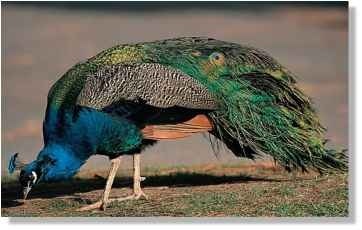
Profile
Common Peafowl
The male’s brilliant plumage is designed to attract his mates, but it also provides surprisingly good camouflage in the dappled light of the forest.
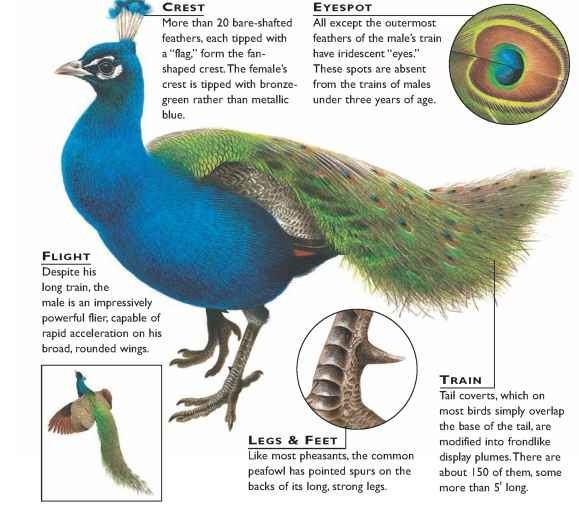
CREATURE COMPARISONS
Although none of its relatives outshines the common peafowl, all male birds of the pheasant family are gaudily clad in vivid plumage.The train of the great argus pheasant is formed by much enlarged wing and tail feathers, which are raised above its head in its dramatic display. This bird lives in Malaysia and
Indonesia.The gray peacock pheasant of Southeast Asia spreads its wings and tail
to show off the glossy eyespots that adorn its subtly colored plumage.

Great argus pheasant


Common peafowl Gray peacock pheasant
| vital Weight |
statistics Male 9-13 lbs.; female 6-8 lbs. |
| Length | Male with train 6-7′; female 36-40″ |
| Wingspan | Male 4-5′; female 30-52″ |
| Sexual Maturity | 3 years |
| Breeding Season | Varies to coincide with monsoon rains |
| Number of Eggs | Usually 3-6 |
| Incubation Period | 28-30 days |
| Fledging Period | 3 weeks |
| Typical Diet | Seeds, fruits, insects, small mammals and reptiles |
| Lifespan | Up to 20 years |
RELATED SPECIES
• There are 49 species of pheasant, including the common peafowl. The rare green peafowl (below) is the other member of the genus Pavo.

